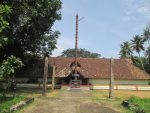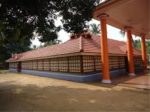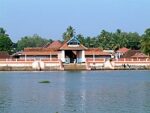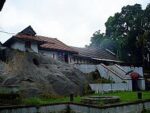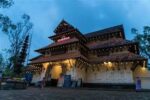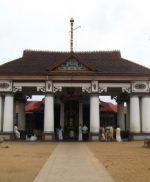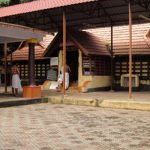Temple Name:
Alternate Spellings:
Sri Imayavarappa Perumal Temple
Listing Category
Location:
Chengannur
Address:
Chengannur, Kerala
689121
689121
District:
Alapuzha
Google Tag:
9°19′36″N 76°36′15″E
Phone No:
0479 245 6672
Email id:
NA
Temple Timings:
4 AM to 11:00 AM | 5 PM to 8 PM
Temple Type:
Dewaswom
Presiding deity:
Imayavarappa Perumal (Vishnu)
Sub Deities:
NA
Festivals:
The two major festivals celebrated in the temple are Vaikunta Ekadasi and Thiruvonam.
From 1957, the festival of Gosala Krishna Temple at Thiruvanvandoor commences from Thrichittatt Maha Vishnu temple when 25 caparisoned elephants are paraded to the Thiruvanvandoor.
From 1957, the festival of Gosala Krishna Temple at Thiruvanvandoor commences from Thrichittatt Maha Vishnu temple when 25 caparisoned elephants are paraded to the Thiruvanvandoor.
History:
Earliest references to this temple appear in the poems and hymns composed by the greatest of Alvar saints - Nammalvar, in circa 800 AD. Stone inscriptions in the temple date it back to the Second Chera Empire (800 - 1102 AD).[5] In modern times, the temple is administered by Travancore Devaswom Board of the Government of Kerala.[6] There are no historical records to indicate when the temple was built. As per local legend, the temple was believed to have been built by Devas.
It is one of the five ancient shrines in the Chengannur area of Kerala, connected with the legend of Mahabharata. Legend has it that the Pandava princes, after crowning Parikshit as king of Hastinapura left on a pilgrimage. On arriving on the banks of river Pamba, each one is believed to have installed a tutelary image of Krishna; Thrichittatt Maha Vishnu Temple by Yudhishthira, Puliyur Mahavishnu Temple by Bheema, Aranmula Parthasarathy Temple by Arjuna, Thiruvanvandoor Mahavishnu Temple by Nakula and Thrikodithanam Mahavishnu Temple by Sahadeva.
During Mahabharata war, Yudhishthira, the head of the Pandavas, who never before uttered a lie, lied in one instant to defeat his Guru, Dronacharya. To overcome the sin of the lie, he underwent penance worshiping the lord here. Imayavar (Devas) came to this place prior to Yudhishthira and hence the deity here is referred as Imayavarappar.[3] There is another version that the Pandavas worshipped the idols during the reign and started installing them in different places during the end of the reign.
Thiruchittattu temple, is considered to be one among the 108 most sacred place of worship, where Lord Vishnu himself resides.
It is one of the five ancient shrines in the Chengannur area of Kerala, connected with the legend of Mahabharata. Legend has it that the Pandava princes, after crowning Parikshit as king of Hastinapura left on a pilgrimage. On arriving on the banks of river Pamba, each one is believed to have installed a tutelary image of Krishna; Thrichittatt Maha Vishnu Temple by Yudhishthira, Puliyur Mahavishnu Temple by Bheema, Aranmula Parthasarathy Temple by Arjuna, Thiruvanvandoor Mahavishnu Temple by Nakula and Thrikodithanam Mahavishnu Temple by Sahadeva.
During Mahabharata war, Yudhishthira, the head of the Pandavas, who never before uttered a lie, lied in one instant to defeat his Guru, Dronacharya. To overcome the sin of the lie, he underwent penance worshiping the lord here. Imayavar (Devas) came to this place prior to Yudhishthira and hence the deity here is referred as Imayavarappar.[3] There is another version that the Pandavas worshipped the idols during the reign and started installing them in different places during the end of the reign.
Thiruchittattu temple, is considered to be one among the 108 most sacred place of worship, where Lord Vishnu himself resides.
Updated on:
05/07/2019 by Komal
Temple Name:
Alternate Spellings:
Thrikkavu Durga
Listing Category
Significance:
108 Durga Temple
Location:
Ponnani
Address:
Thrikkavu Temple Rd, Keezhillam, Ponnani, Kerala
679577
679577
District:
Malappuram
Phone No:
0494 266 9778
Temple Timings:
9.30 AM to 1.30 PM and from 5.30 PM to 7.30 PM
Presiding deity:
Sri Durga Bhagavathy, worshipped in three different forms: Parvati, Lakshmi and Saraswati.
Sub Deities:
Mahaganapathi | Sasthavu Sidhi Vinayakan | Hanuman | Brahma Rakshass | Naga Raja | Naga Yakshi | Naga pratishtas
Festivals:
The main festival is Navarathri Mahotsavam which attracts large number of devotees.
Vidyarambham (beginning of formal education) is conducted on the Vijayadasami day of Navarathri utsavam. Thousands of children throng this temple on that day. The Vrishchicka Mandala mahotsavam (festival) is celebrated during the entire period of mandalam season.
Vidyarambham (beginning of formal education) is conducted on the Vijayadasami day of Navarathri utsavam. Thousands of children throng this temple on that day. The Vrishchicka Mandala mahotsavam (festival) is celebrated during the entire period of mandalam season.
Updated on:
05/07/2019 by Komal
Temple Name:
Listing Category
Location:
Irinjalakuda
Address:
Sree Thrippayya Thrimoorthi Kshethram
Nadavaramba
680 661
Nadavaramba
680 661
District:
Thrissur
Google Tag:
10.327129,76.219100
Phone No:
0480 283 1331
Email id:
info@thrippayyatemple.com
Temple Timings:
5:00am – 8.30 am | 5:00 pm – 7:30 pm
Temple Type:
Other
If Other is Chosen, pls specify:
Kshema Samithy
Presiding deity:
Lord Rama
Sub Deities:
Along with Lord Rama, there are shrines for Lord Shiva as Dakshinamoorthy, Lord Ganesha, Lord Sastha and Lord Krishna, and there is idol-less worship for Lord Hanuman and Lord Chathan.
Festivals:
Arattupuzha Pooram, Ekadasi, Sethubandhanam at Sreeraman Chira Chemmappilly
History:
There are no written scriptures, which could establish the exact date of the construction of the Thriprayar temple or any other incidence. A popularly believed legend throws light on how the temple was constructed and what is the story behind its construction. According to that legend, the idols of Lord Rama and that of his brothers Lakshman, Bharat and Shatrughna, were washed ashore and were found at Thriprayar, Tirumoozhikkalam, Koodalmanikyam and Payammel, respectively. The idols were found by a chieftain named Vakkel Kaimal.
After consulting from a number of astrologers, the chieftain decided to install at a place where peacocks were found and so was done. Later, the decendents of Vakkel Kaimal moved further south and settled at Niranam and Thalavady. They worshipped Thrikapaleswar, a form of Lord Siva for attaining the lotus feet of lord Krishna. One of the son who was known as Thachudaya kaimal decided to reside at reside at Irinjalakuda. He was the one who was entrusted as the caretaker of the deities. It is considered that if a person worships the four deities in one day, he attains salvation.
After consulting from a number of astrologers, the chieftain decided to install at a place where peacocks were found and so was done. Later, the decendents of Vakkel Kaimal moved further south and settled at Niranam and Thalavady. They worshipped Thrikapaleswar, a form of Lord Siva for attaining the lotus feet of lord Krishna. One of the son who was known as Thachudaya kaimal decided to reside at reside at Irinjalakuda. He was the one who was entrusted as the caretaker of the deities. It is considered that if a person worships the four deities in one day, he attains salvation.
Updated on:
05/07/2019 by Komal
Temple Name:
Listing Category
Location:
Trikkur
Address:
Trikkur Mahadeva Kshetram,
Trikkur
680306
Trikkur
680306
District:
Thrissur
Google Tag:
NA
Phone No:
0487- 2359500
Email id:
trikkurmahadevan@gmail.com
Temple Timings:
Morning: 7:00 AM to 10:00 AM Evening: 5:00 PM to 8:00 PM
Presiding deity:
Lord Mahadeva / Lord Shiva
Sub Deities:
Ganapathi / Sastha / Anthimahakalan / Bhadrakali / Bhagavathi / Chamundi | Nagayakshi and Nagaraja.
Offerings:
Dhara (Abhishekam)
(Bilwa / Koovaram)
Pushpanjali
(Bilwa / Koovaram)
Pushpanjali
Festivals:
Various festivals such as Thiruvathira, Mahashivaratri, Navaratri and Pradosha Puja are celebrated with great pomp in this temple and people from different parts of the world come to this small village to participate in the celebrations and obtain the blessings of Lord Thrikkurappan.
History:
Trikkur is located on the banks of the Manali River, about 10 km north-east of Thrichur. The Trikkur Mahadeva Temple is located about 200 m above sea level. In this temple, Shiva resides as Syambhoo. The majestically beautiful deity is more than six feet tall and more than two feet wide. The Sanctum Sanctorum is located inside a cave twelve feet long and eight feet wide. The cave opens to the north. In front of the sanctum sanctorum, there is a Mugha mandapa, entirely carved in the rock. Although the deity looks east during Darshan, the devotees can only see the right side of the Linga. (“Parshwa Darshan”.)
It is believed that the temple was created by the Lord Agni the Lord of Fire. It is also believed that Agni resides eternally with Lord Shiva. For this reason, the Ezhunnellath (the accompaniment of divinity outside the temple) is never done on rainy days or on days when the atmosphere is cloudy.
The goddess Parvathi also resides perpetually to Lord Shiva, personifying knowledge. Lord Ganapathi is carved on the wall of the cave towards the west side of the sanctuary. On the east side are two Dwarapalakas and in the Mugha Mandapa, there is a Saalagrama, which would have a huge Chaithanya Vaishnava.
The rock-laden soil and the Namasakara Mandapa, built from sixteen rock pillars, present a large number of beautiful sculptures. To the north of the temple is a hall where Saraswati Pooja and Chakyar Koothu are led during Navratri and Utsavas respectively.
It is also believed that this temple was first found by a person, belonging to a class considered untouchable in those days. He had been searching for his cow that had gone grazing when he chanced upon this cave. He found the cow in the cave along with the magnificent form of Lord Shiva. He immediately ran and reported this to his master, a Namboodiri.
The Namboodiri, seeing the magnificent form of the Lord manifested in the cave, performed poojas to him. A floor has been erected in front of the temple, in memory of the man who had first sighted this temple. In the Utsava times, it is on this floor, that Kurathiyattam is performed. Since it was here that the temple was sighted – the village was named Dhrukpuram. (Dhrushti – sight) . Over time, the word Dhrukpuram shortened to Trikkur, goes the myth.
It is believed that the temple was created by the Lord Agni the Lord of Fire. It is also believed that Agni resides eternally with Lord Shiva. For this reason, the Ezhunnellath (the accompaniment of divinity outside the temple) is never done on rainy days or on days when the atmosphere is cloudy.
The goddess Parvathi also resides perpetually to Lord Shiva, personifying knowledge. Lord Ganapathi is carved on the wall of the cave towards the west side of the sanctuary. On the east side are two Dwarapalakas and in the Mugha Mandapa, there is a Saalagrama, which would have a huge Chaithanya Vaishnava.
The rock-laden soil and the Namasakara Mandapa, built from sixteen rock pillars, present a large number of beautiful sculptures. To the north of the temple is a hall where Saraswati Pooja and Chakyar Koothu are led during Navratri and Utsavas respectively.
It is also believed that this temple was first found by a person, belonging to a class considered untouchable in those days. He had been searching for his cow that had gone grazing when he chanced upon this cave. He found the cow in the cave along with the magnificent form of Lord Shiva. He immediately ran and reported this to his master, a Namboodiri.
The Namboodiri, seeing the magnificent form of the Lord manifested in the cave, performed poojas to him. A floor has been erected in front of the temple, in memory of the man who had first sighted this temple. In the Utsava times, it is on this floor, that Kurathiyattam is performed. Since it was here that the temple was sighted – the village was named Dhrukpuram. (Dhrushti – sight) . Over time, the word Dhrukpuram shortened to Trikkur, goes the myth.
Updated on:
05/07/2019 by Komal
Temple Name:
Alternate Spellings:
Vadakkunnathan Temple
Significance:
Vadakkumnathan Temple is an ancient Hindu temple dedicated to Shiva at the city of Thrissur, of Kerala state in India. This temple is a classical example of the architectural style of Kerala and has one monumental tower on each of the four sides in addition to a kuttambalam. Mural paintings depicting various scenes from the Mahabharata can be seen inside the temple. The shrines and the Kuttambalam display vignettes carved in wood. The temple, along with the mural paintings, has been declared as a National Monument by India under the AMASR Act. According to popular local lore, this is the first temple built by Parasurama, the sixth avatara of Vishnu. Thekkinkadu Maidan, encircling the Vadakkumnathan Temple, is the main venue of the renowned Thrissur Pooram festival.In the year 2012 the Archaeological Survey of India (ASI) has recommended 14 sites, including Vadakkumnathan Temple and palaces, from Kerala to include in the list of UNESCO World Heritage Sites. The temple is also the first one among the 108 Shiva Temples in ancient Kerala, established by Parasurama.
Location:
Thekkinkad Maidanam
Address:
G6F7+QRR, Swaraj Round N, Kuruppam, Thekkinkadu Maidan, Thrissur, Kerala
680001
680001
District:
Thrissur
Google Tag:
10.524451806622315, 76.21446968465672
Phone No:
0487 242 6040
Temple Timings:
Tuesday 4–11am, 5–8:20pm Wednesday 4–11am, 5–8:20pm Thursday 4–11am, 5–8:20pm Friday 4–11am, 5–8:20pm Saturday 4–11:30am, 5–8:15pm Sunday 4–11:30am, 5–8:15pm Monday 4–11am, 5–8:20pm
Temple Type:
Dewaswom
Presiding deity:
Shiva
Sub Deities:
Parvati; Shankaranarayana; Vishnu (as Rama); Ganapati
Offerings:
Pushpanjali Rs.12.00
Ganapathy Homam Rs.90.00
Ennayattam (Sree Raman) Rs.600.00
Maala Pooja Rs.24.00
Lalitha Sahasranamarchana Rs.36.00
Vilwadhalarchana Rs.36.00
Special Neypayasam Rs.80.00
Palpayasam Rs.100.00
Appam Rs.145.00
Ottayappam Rs.100.00
Swayamvararchana Rs.36.00
Maala Rs.15.00
Dhara Rs.60.00
Vella Nivedhyam Rs.30.00
Umamaheswara Pooja Rs.120.00
Sumangali Pooja Rs.120.00
Mrithyunjaya Homam Rs.300.00
Noorum Paalum (Nagangal) Rs.60.00
Ashtadravya Ganapathi Homam (Big) Rs.600.00
Ashtadravya Ganapathi Homam (Small) Rs.300.00
Bagyasooktham Rs.36.00
Chandana Charthu Rs.480.00
Kettunira Rs.36.00
Maala Charthu (Onnu Nadakkal) Rs.330.00
101 Kudam (Rishaban) Rs.300.00
51 Kudam (Rishaban) Rs.210.00
Maha Mrithyunjaya Homam Rs.600.00
Sangabhishekam Rs.120.00
Chooroonu Rs.120.00
Vidyarambam Rs.60.00
Vahana Pooja Rs.360.00
Vivaham Rs.600.00
Aikyamathyam Rs.36.00
Avilkootu Rs.50.00
Naga Pooja Rs.120.00
Shaneeswara Pooja Rs.120.00
Sree Rudrajapam Rs.270.00
Veliyothu Pushpanjali Rs.36.00
Bhrahma Rakshasu Pooja Rs.120.00
Gouree Sankara Pooja Rs.120.00
Gandharva Pooja Rs.120.00
Neyyattam (Vadakkunnathan) Rs.1,320.00
Thrikala Pooja Rs.600.00
Niramala Chuttuvilakku Full Rs.10,000.00
Niramala Nadakkal Rs.1350.00
Udhyasthamana Pooja Rs.90,000.00
18 ½ Paranivedyam Rs.15,000.00
18 ½ Idangazhi Nivedyam Rs.1000.00
Swarna Thaali Rs.300.00
Pattu Rs.70.00
Thattu Panam Rs.60.00
Adima Rs.192.00
Nelppara Rs.150.00
Arippara Rs.250.00
Elluppara Rs.250.00
Sarkkarappara Rs.300.00
Manjalpodi Para Rs.550.00
Avilpara Rs.160.00
Panchasarapara Rs.300.00
Malarpara Rs.100.00
Annadhanam (A) Rs.20,000.00
Annadhanam (B) Rs.15,000.00
Neypayasam Rs.100.00
Enna Rs.9.00
Neyyu Rs.21.00
Thrikkai Venna Rs.60.00
Ellu Kizhi Rs.10.00
Neeranjanam Rs.60.00
Manjalpodi Rs.12.00
Karuka Homam Rs.60.00
Sreerudhradaara Rs.600.00
Innamala Rs.300.00
Ganapathy Homam Rs.90.00
Ennayattam (Sree Raman) Rs.600.00
Maala Pooja Rs.24.00
Lalitha Sahasranamarchana Rs.36.00
Vilwadhalarchana Rs.36.00
Special Neypayasam Rs.80.00
Palpayasam Rs.100.00
Appam Rs.145.00
Ottayappam Rs.100.00
Swayamvararchana Rs.36.00
Maala Rs.15.00
Dhara Rs.60.00
Vella Nivedhyam Rs.30.00
Umamaheswara Pooja Rs.120.00
Sumangali Pooja Rs.120.00
Mrithyunjaya Homam Rs.300.00
Noorum Paalum (Nagangal) Rs.60.00
Ashtadravya Ganapathi Homam (Big) Rs.600.00
Ashtadravya Ganapathi Homam (Small) Rs.300.00
Bagyasooktham Rs.36.00
Chandana Charthu Rs.480.00
Kettunira Rs.36.00
Maala Charthu (Onnu Nadakkal) Rs.330.00
101 Kudam (Rishaban) Rs.300.00
51 Kudam (Rishaban) Rs.210.00
Maha Mrithyunjaya Homam Rs.600.00
Sangabhishekam Rs.120.00
Chooroonu Rs.120.00
Vidyarambam Rs.60.00
Vahana Pooja Rs.360.00
Vivaham Rs.600.00
Aikyamathyam Rs.36.00
Avilkootu Rs.50.00
Naga Pooja Rs.120.00
Shaneeswara Pooja Rs.120.00
Sree Rudrajapam Rs.270.00
Veliyothu Pushpanjali Rs.36.00
Bhrahma Rakshasu Pooja Rs.120.00
Gouree Sankara Pooja Rs.120.00
Gandharva Pooja Rs.120.00
Neyyattam (Vadakkunnathan) Rs.1,320.00
Thrikala Pooja Rs.600.00
Niramala Chuttuvilakku Full Rs.10,000.00
Niramala Nadakkal Rs.1350.00
Udhyasthamana Pooja Rs.90,000.00
18 ½ Paranivedyam Rs.15,000.00
18 ½ Idangazhi Nivedyam Rs.1000.00
Swarna Thaali Rs.300.00
Pattu Rs.70.00
Thattu Panam Rs.60.00
Adima Rs.192.00
Nelppara Rs.150.00
Arippara Rs.250.00
Elluppara Rs.250.00
Sarkkarappara Rs.300.00
Manjalpodi Para Rs.550.00
Avilpara Rs.160.00
Panchasarapara Rs.300.00
Malarpara Rs.100.00
Annadhanam (A) Rs.20,000.00
Annadhanam (B) Rs.15,000.00
Neypayasam Rs.100.00
Enna Rs.9.00
Neyyu Rs.21.00
Thrikkai Venna Rs.60.00
Ellu Kizhi Rs.10.00
Neeranjanam Rs.60.00
Manjalpodi Rs.12.00
Karuka Homam Rs.60.00
Sreerudhradaara Rs.600.00
Innamala Rs.300.00
Festivals:
Maha Shivaratri
Maha Shivaratri is the main festival which is celebrated in the temple. Cultural and musical programmes are held in the temple premises. Around one lakh temple lamps (hundred thousand)are lighted in the festival. The idol of Vadakkumnatha is not taken out for procession. On this day, there will he continuous abhishekam with ghee and tender coconut. The temple is not closed in the night, and there will be special poojas with abhishekam on the day. Vadakkumnathan Temple's Thekke Gopura Vathil lighted up during the Maha Shivaratri festival.
Aanayoottu
The Aanayoottu of feeding of elephants, is the second biggest festival held in the temple. The devotees refer to elephants as Lord Ganesh's incarnation. The festival falls on the first day of the month of Karkkidakam (timed against the Malayalam calendar), which coincides with the month of July. It has been the regular annual practice at the temple for the last 20 years to conduct a large-scale Ashta Dravya Maha Ganapathy Havana and Aanayoottu on the first day of the Karkidakom month of the Malayalam calendar. It involves a number of unadorned elephants being positioned amid a multitude of people for being worshipped and fed. A large number of people throng the temple to feed the elephants. Gajapooja also is conducted once every four years.
Thrissur Pooram
Thrissur Pooram is called the mother of all Poorams in Kerala. In Malayalam it's called "poorangalude pooram". This is conducted in the Malayalam month of Medam. The deities from Parmekavu and Thiruvambady temple along with other small poorams come engage in festivities in front of Vadakkumanathan. It's a 36 long hour festival which attracts thousands of enthusiasts from all over the state as well as visitors from other regions and abroad. The main attractions of Pooram are Madathilavaravu panchavadhyam, Elanjithara melam, Kudamattam and Vedikettu. The festival is a visual feast for all those who enjoy it
Maha Shivaratri is the main festival which is celebrated in the temple. Cultural and musical programmes are held in the temple premises. Around one lakh temple lamps (hundred thousand)are lighted in the festival. The idol of Vadakkumnatha is not taken out for procession. On this day, there will he continuous abhishekam with ghee and tender coconut. The temple is not closed in the night, and there will be special poojas with abhishekam on the day. Vadakkumnathan Temple's Thekke Gopura Vathil lighted up during the Maha Shivaratri festival.
Aanayoottu
The Aanayoottu of feeding of elephants, is the second biggest festival held in the temple. The devotees refer to elephants as Lord Ganesh's incarnation. The festival falls on the first day of the month of Karkkidakam (timed against the Malayalam calendar), which coincides with the month of July. It has been the regular annual practice at the temple for the last 20 years to conduct a large-scale Ashta Dravya Maha Ganapathy Havana and Aanayoottu on the first day of the Karkidakom month of the Malayalam calendar. It involves a number of unadorned elephants being positioned amid a multitude of people for being worshipped and fed. A large number of people throng the temple to feed the elephants. Gajapooja also is conducted once every four years.
Thrissur Pooram
Thrissur Pooram is called the mother of all Poorams in Kerala. In Malayalam it's called "poorangalude pooram". This is conducted in the Malayalam month of Medam. The deities from Parmekavu and Thiruvambady temple along with other small poorams come engage in festivities in front of Vadakkumanathan. It's a 36 long hour festival which attracts thousands of enthusiasts from all over the state as well as visitors from other regions and abroad. The main attractions of Pooram are Madathilavaravu panchavadhyam, Elanjithara melam, Kudamattam and Vedikettu. The festival is a visual feast for all those who enjoy it
History:
The temple was built at the time of Perumthachan from Parayi petta panthirukulam. It is said that Perumthachan lived during the second century; so the Koothambalam may be more than 1,600 years old. According to Malayalam historian V. V. K. Valath, the temple was a pre-Dravidian Kavu (shrine). In the early days, Paramekkavu Bhagavathi was also situated inside the Vadakkunnathan temple. Subsequently, a new temple was built outside and the idol of the goddess was moved to that location. For comparison, Koodalmanikyam Temple, Kodungallur Bhagavathy Temple and Ammathiruvadi Temple, Urakam are older than the Vadakkunnathan temple, according to temple documents. Some suggest that there have also been influences from Buddhist and Jain temples.
Yogiatiripppads
The Nambudiris who were entrusted with looking after temple affairs were called Yogiatiripppads. When Nambudiris gained control of the region, the temple also came under their domain. The Yogiatiripppads were elected from Thrissur desam. Prior to Sakthan Thampuran's reign, the Yogiatiripppad system declined. Later, the Maharaja of Cochin gained presiding authority over the temple.
Adi Shankara
Adi Shankara is believed to have been born (788 AD) to Shivaguru and Aryamba of Kalady consequent to their prayers to lord Vadakkumnathan, as amsavatara of Shiva. The couple devoutly prayed for 41 days at the temple. Legend has it that Shiva appeared to the couple in their dreams and offered them a choice. They could have either a mediocre son who would live a long life or an extraordinary son who would die early. Both Shivaguru and Aryamba chose the latter. In honour of Shiva, they named their son Shankara. According to legend, Adi Shankara attained videha mukti ("freedom from embodiment") at the Vadakkunnathan temple. One narrative as expounded by the Keraliya Shankaravijaya, identifies the temple as his place of death. He also established four Mutts at Thrissur, famously known as Edayil Madhom, Naduvil Madhom, Thekke Madhom and Vadakke Madhom
Invasion of Tipu Sultan
During the invasion of Tipu Sultan, the temple was not attacked by Tipu's Army. Even though Tipu Sultan destroyed many temples in Thrissur district at that time, he never touched Vadakkumnathan Temple. According to historical accounts, when Tipu Sultan was marching towards the Travancore lines, known locally as Nedumkotta, he had a short stay at Thrissur city from 14 to 29 December 1789. In order to feed his Army, he had borrowed cooking vessels from Vadakkumnathan Temple. Before leaving Thrissur city, he not only returned the vessels, but presented the temple with a large bronze lamp.Thouge it is completely contradicting since it is against his original nature. Historians have different tales about it without primary sorce as reference other than their own book and belief.
Zamorin of Calicut
During 1750 to 1762, the temple affairs were conducted by Zamorin of Calicut who attacked Thrissur city and took control of the temple and the city. In 1762 with the help of Kingdom of Travancore, Maharaja of Cochin regained control over Thrissur city and the temple.
Sakthan Thampuran
When Sakthan Thampuran (1751–1805), ascended the throne of Kingdom of Cochin, he changed the capital of Kingdom of Cochin from Thripunithura to Thrissur city as the King had a personal relationship with Vadakkumnathan Temple. He later cleared the teak forest around the temple and introduced the famous Thrissur Pooram festival. The King's personal interest in the temple also changed the fortune of the city.
Structure
The temple is situated on an elevated hillock in the centre of Thrissur City and is surrounded by a massive stone wall enclosing an area of nearly 9 acres (36,000 m2). Inside this fortification, there are four gopurams facing four cardinal directions. Between the inner temple and the outer walls, there is a spacious compound, the entrance to which is through gopurams. Of these, the gopurams on the south and north are not open to the public. The public enter either through the east or west gopuram. The inner temple is separated from the outer temple by a broad circular granite wall enclosing a broad corridor called Chuttambalam. Entrance into the inner temple is through a passage through the corridor.
Yogiatiripppads
The Nambudiris who were entrusted with looking after temple affairs were called Yogiatiripppads. When Nambudiris gained control of the region, the temple also came under their domain. The Yogiatiripppads were elected from Thrissur desam. Prior to Sakthan Thampuran's reign, the Yogiatiripppad system declined. Later, the Maharaja of Cochin gained presiding authority over the temple.
Adi Shankara
Adi Shankara is believed to have been born (788 AD) to Shivaguru and Aryamba of Kalady consequent to their prayers to lord Vadakkumnathan, as amsavatara of Shiva. The couple devoutly prayed for 41 days at the temple. Legend has it that Shiva appeared to the couple in their dreams and offered them a choice. They could have either a mediocre son who would live a long life or an extraordinary son who would die early. Both Shivaguru and Aryamba chose the latter. In honour of Shiva, they named their son Shankara. According to legend, Adi Shankara attained videha mukti ("freedom from embodiment") at the Vadakkunnathan temple. One narrative as expounded by the Keraliya Shankaravijaya, identifies the temple as his place of death. He also established four Mutts at Thrissur, famously known as Edayil Madhom, Naduvil Madhom, Thekke Madhom and Vadakke Madhom
Invasion of Tipu Sultan
During the invasion of Tipu Sultan, the temple was not attacked by Tipu's Army. Even though Tipu Sultan destroyed many temples in Thrissur district at that time, he never touched Vadakkumnathan Temple. According to historical accounts, when Tipu Sultan was marching towards the Travancore lines, known locally as Nedumkotta, he had a short stay at Thrissur city from 14 to 29 December 1789. In order to feed his Army, he had borrowed cooking vessels from Vadakkumnathan Temple. Before leaving Thrissur city, he not only returned the vessels, but presented the temple with a large bronze lamp.Thouge it is completely contradicting since it is against his original nature. Historians have different tales about it without primary sorce as reference other than their own book and belief.
Zamorin of Calicut
During 1750 to 1762, the temple affairs were conducted by Zamorin of Calicut who attacked Thrissur city and took control of the temple and the city. In 1762 with the help of Kingdom of Travancore, Maharaja of Cochin regained control over Thrissur city and the temple.
Sakthan Thampuran
When Sakthan Thampuran (1751–1805), ascended the throne of Kingdom of Cochin, he changed the capital of Kingdom of Cochin from Thripunithura to Thrissur city as the King had a personal relationship with Vadakkumnathan Temple. He later cleared the teak forest around the temple and introduced the famous Thrissur Pooram festival. The King's personal interest in the temple also changed the fortune of the city.
Structure
The temple is situated on an elevated hillock in the centre of Thrissur City and is surrounded by a massive stone wall enclosing an area of nearly 9 acres (36,000 m2). Inside this fortification, there are four gopurams facing four cardinal directions. Between the inner temple and the outer walls, there is a spacious compound, the entrance to which is through gopurams. Of these, the gopurams on the south and north are not open to the public. The public enter either through the east or west gopuram. The inner temple is separated from the outer temple by a broad circular granite wall enclosing a broad corridor called Chuttambalam. Entrance into the inner temple is through a passage through the corridor.
Updated on:
19/07/2022
Temple Name:
Alternate Spellings:
Vaikom Mahadevan
Listing Category
Significance:
Kashi of South
Location:
Vaikom
Address:
Vaikom.P.O, Kottayam (Dist), Kerala
District:
Kottayam
Google Tag:
9° 26′ 5.532” N76° 32′ 27.168” E
Phone No:
04829215812
Email id:
NA
Temple Timings:
3:30 am – 11:30am | 5pm – 8pm
Temple Type:
Dewaswom
Presiding deity:
Lord Shiva
Sub Deities:
NA
History:
Kharasura on receiving the Shaiva Vidya Upadesh from Malyavan went to Chidambaram, and did severe penance and Tapasya for the attainment of Moksha. Pleased with his penance Lord Siva granted all the boons he asked, and presented him with three great Siva Lingas drawn out of Him. Assuring that He will ever be present in them, Lord Siva disappeared, asking Khara to worship the Lingas to attain Moksha. When Khara was returning south from Himalayas with the three Lingas, one in his right hand, one in left hand and other by the neck, he felt tired and rested awhile. After rest when he tried to pick up the lingas, they wouldn't budge. He realized that it was Shiva's maya and when called unto, the heavens spoke thus, "I shall remain here giving Moksha to whom so ever * take refuge in Me". Khara having attained Moksha entrusted the holy Lingas to the custody of Maharshi Vyaghrapada who had followed him invisibly and asked the sage to protect and worship them.
Updated on:
05/07/2019 by Komal
Temple Name:
Alternate Spellings:
Valiakoikkal Temple
Listing Category
Significance:
It is believed that Lord Ayyappa himself instructed the Pandalam king to build a mosque for Vavur at Erumuli. The Vavur deity is believed to be as old as the original deity of Ayyappa himself. Records show that the shrine was renovated sometime in 1905. Here, the poojas are conducted by a Muslim priest. There is no distinguishable idol, but a carved stone slab that represents the deity.
It is believed that the deity protects the devotees from the evil spirits of the forests. According to legend, Kadutha was a great warrior who helped the Pandalam king defeat the armies of Udayanan and other enemies.
It is believed that the deity protects the devotees from the evil spirits of the forests. According to legend, Kadutha was a great warrior who helped the Pandalam king defeat the armies of Udayanan and other enemies.
Location:
Pandalam
Address:
National Highway 220, Pandalam, Pathanamthitta, Kerala
District:
Pathanamthitta
Google Tag:
9.32°N 76.73°E
Temple Type:
Family Owned
Presiding deity:
Ayyappan
Sub Deities:
NA
Updated on:
05/07/2019 by Komal
Temple Name:
Significance:
Veliyannoor Bhagavathy temple, also known as Veliyannur Kavu Bhagavathy Temple, is located in Veliyannur near Thrissur town in Kerala. The temple is one among the 108 Durga temples in Kerala.
Goddess Bhagavathi worshipped here is in Kali Sankalpam. The darshanam of Veliyannur Bhagavathy is towards east.
Tantric puja are held during auspicious occasions.
The Upa Devata worshipped in the temple is Ganapathy.
The annual festival in the temple is known as Vishu Vela and is held on the Vishu day in Medam month (April 14 or April 15). Navratri is another important festival here.
Goddess Bhagavathi worshipped here is in Kali Sankalpam. The darshanam of Veliyannur Bhagavathy is towards east.
Tantric puja are held during auspicious occasions.
The Upa Devata worshipped in the temple is Ganapathy.
The annual festival in the temple is known as Vishu Vela and is held on the Vishu day in Medam month (April 14 or April 15). Navratri is another important festival here.
Location:
Veliyannur
Address:
G686+2CR, SH22, Veliyannur, Thrissur, Kerala 680021
680021
680021
District:
Thrissur
Google Tag:
10.515975689276626, 76.2108908539757
Website:
Presiding deity:
Bhagavathy
Updated on:
16/08/2022
